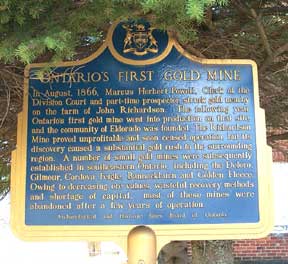|
 Ontario's Ontario's
first gold rush
by June Payne Flath
Gold is unique. It glows with an iridescence.
It will not corrode, rust or tarnish. It is malleable—some
say one ounce of gold can be drawn into a wire from 8 to 64
kilometres (40 miles long)—yet it is very dense, 19 times
heavier than water.
Canada is one of five countries that together
produce about 90 percent of the world’s gold. South Africa
leads the pack with the former USSR, Australia, the United
States and Canada following behind. More than half of the
Canadian output comes from the Pre-Cambrian Shield in northern
Ontario.
Ontario’s first discovery of gold
was declared on August 15, 1866, when 21-year-old Marcus Powell
in Hastings County spoke the words, “I discovered gold.”
Powell was trenching along a seam of copper on Richardson’s
farm when his pick broke through a cavity and opened into
a cave. The hanging wall was quartzite while the foot wall
was granite. The floor was iron, talc, quartzite, black mica
and other minerals, with gold leaves and nuggets found in
all these rocks. The largest nugget was the size of a butternut.
It took a while for word to get out, and
at first people didn’t believe him. But once the announcement
was made, a dozen mines and a collection of boom towns sprouted
from that rocky farmland near Belleville.
Madoc was the nearest town to the gold
fields, but only one stage ran from Belleville on the Grand
Trunk Railway. Getting to the gold rush site was as much of
a challenge as finding the gold. Four coaches and two covered
stages were brought into service. Prospectors picked up at
Belleville hotels at 7:30 a.m. were in Madoc by noon.
In the meantime, south of the discovery,
surveyor Charles Aylesworth got to work subdividing the northeast
corner of John Moore’s farm into 126 quarter-acre village
lots. Within weeks there were 80 buildings in the new settlement.
This boom town is Eldorado. Legend has
it that at the peak of the Hastings County gold rush, it cost
50 cents per night to sleep under a wagon in the vicinity
of Eldorado. Most gold-seekers chose to come to the established
town of Madoc, which swelled with service industries and hotels
eager to accommodate the influx of newcomers.
At least 26 roadhouses mushroomed between
Belleville and Eldorado. Excitement and population peaked
in April when it is believed that 4,000 prospectors, investors
and curiosity seekers arrived in central Hastings.
Land speculation was as lucrative as digging
for gold. Speculators bought and sold, price tags climbing
with each sale. Legend tells of one owner who sold 1 1/4 acres
of land for $700, only to learn that that same piece of land
sold for $4,000 an hour later. Those who weren’t selling
land or services were publishing books or giving lectures
on how to find gold.
One businessman, along with two American
sidekicks, was trying to stir up local investors for the Richardson
site. Richardson gave them a 30-day option on 19 acres of
land on his farm for $20,000 and allowed them to take several
barrels of rich ore as samples.
Richardson never saw any of the promised
money and so began another business deal with three other
men. These men paid him $36,000 in cash. Richardson immediately
gave young Powell $16,000 for discovering the gold. When the
first group of investors heard Richardson had gone elsewhere,
they took Richardson and the new owners to court. The courts
sided with those who had actually paid money for their deal,
and a building was erected near the main shaft and an armed
guard put on duty.
Rumours ran thick. One rumour claims the
guard did a lively business selling loose gold specimens.
Another claimed the mine was worthless and a “con”
to drive up land prices. Tension grew so bad between mine
owners and prospectors that a team of Mounties was sent to
keep the peace.
Before the Mounties arrived, 200 men marched
on the offices of the Richardson mine and confronted the manager.
They demanded to see gold, promising to pull the office down
around his ears if he didn’t comply. He let a few of
them into the mine and down into the gold cellar.
When these men returned to the surface,
the spokesman for the group climbed up onto a stump and declared
they were satisfied with the richness of the mine. They claimed
that from a quart of dirt they had washed $13 of gold. The
group gave three cheers and headed for a tavern.
Of 30 mine shafts only one-third showed
gold, and by 1870 even the mines that had been productive
were running dry. During the initial excitement, dozens of
mining companies were established by investors throughout
the gold region and beyond, including Hamilton, Toronto, Peterborough,
Belleville, Kingston and Montreal.
In July, 1867, the gold rush began a new
phase. Large companies entered the picture replacing individuals.
They brought with them large quartz crushers, steel sieves
and grinding pans that cost thousands of dollars. Two of the
stage lines between Madoc and Belleville withdrew their service,
and the Madoc hotels were no longer crowded. With fewer strangers
arriving, good bed and board accommodation was once again
easily obtained at a reasonable rate. The prospectors and
miners drifted away in search of new trails of gold dust.
This is an original story,
first published in The Country Connection Magazine,
Issue 51, Spring 2006. Copyright June Payne Flath.
RETURN
TO STORY INDEX
RETURN
TO BACK ISSUE PAGE
To purchase this issue of The Country Connection, please send a cheque to:
Gus Zylstra, 691 Pinecrest Road, Boulter ON K0L 1G0, Canada
In Canada: $4.95 + 2.20 shipping + .93 HST = $8.08
In the USA:$4.95 + 3.80 shipping + 1.14 HST = $9.89
|

